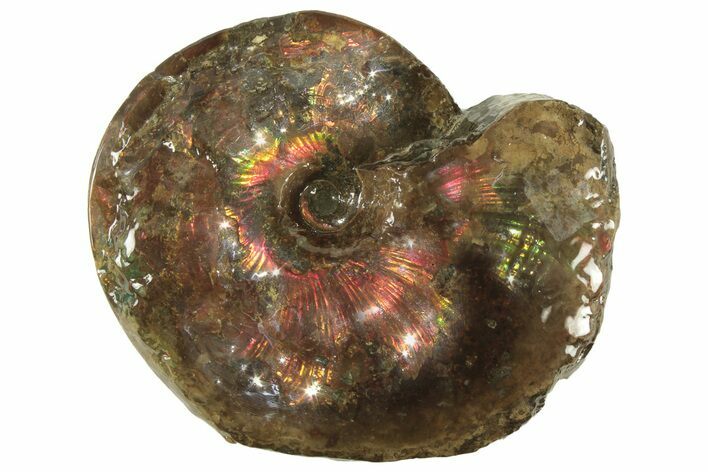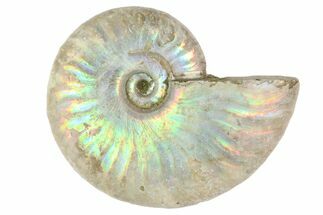This Specimen has been sold.
5.1" Iridescent Ammonite Fossil Preserved In Precious Ammolite!
This is an astonishingly beautiful and nearly complete, brilliant, iridescent ammonite fossil from the Bear Paw Shale of Alberta, Canada. It has wonderful orange, yellow, red, and green hues that shimmer differently depending on what angle the specimen is viewed from. Whole, and nearly whole, ammolite specimens are quite rare in and of themselves. Specimens with excellent color play are even more difficult to come by and should not be overlooked.
These complete, well-preserved, ammolite fossils are quite rare and are truly special. The Canadian government considers them part of the “National Treasures of Canada”. For this reason, all complete specimens must be inspected and registered by the Alberta provincial government. Each ammonite then receives a number and is entered in the provincial database. A cultural property export permit is required for them to be exported from the province. Documentation will be provided with the specimen upon request.
It comes with an acrylic display stand.
These complete, well-preserved, ammolite fossils are quite rare and are truly special. The Canadian government considers them part of the “National Treasures of Canada”. For this reason, all complete specimens must be inspected and registered by the Alberta provincial government. Each ammonite then receives a number and is entered in the provincial database. A cultural property export permit is required for them to be exported from the province. Documentation will be provided with the specimen upon request.
It comes with an acrylic display stand.
About Ammolite
Ammolite is an opal-like gemstone found primarily in Alberta, Canada. It is a kind of fossilized shell from ammonites, which in turn are composed primarily of aragonite, the same mineral contained in nacre (mother-of-pearl). The shell's microstructures are often preserved. In 1981, ammolite was given official gemstone status by the World Jewellery Confederation (CIBJO).
An iridescent opal-like play of color is shown in fine specimens, mostly in shades of green and red; howver, all the spectral colors can be seen. This iridescence is due to the aragonite's microstructure: unlike most other gems, whose colors come from light absorption, the iridescence in ammolite comes from interference with the light that rebounds from stacked layers of thin platelets that make up the aragonite. The thicker the layers, the more reds and greens are produced; the thinner the layers, the more blues and violets predominate. Blues and especially purples are the rarest colors, owing to the greater fragility of the finer layers responsible for these colors.
Ammolite is an opal-like gemstone found primarily in Alberta, Canada. It is a kind of fossilized shell from ammonites, which in turn are composed primarily of aragonite, the same mineral contained in nacre (mother-of-pearl). The shell's microstructures are often preserved. In 1981, ammolite was given official gemstone status by the World Jewellery Confederation (CIBJO).
An iridescent opal-like play of color is shown in fine specimens, mostly in shades of green and red; howver, all the spectral colors can be seen. This iridescence is due to the aragonite's microstructure: unlike most other gems, whose colors come from light absorption, the iridescence in ammolite comes from interference with the light that rebounds from stacked layers of thin platelets that make up the aragonite. The thicker the layers, the more reds and greens are produced; the thinner the layers, the more blues and violets predominate. Blues and especially purples are the rarest colors, owing to the greater fragility of the finer layers responsible for these colors.
SPECIES
Placenticeras sp.
LOCATION
Korite Ammolite Mine, SW Alberta, Canada
FORMATION
Bearpaw Formation
SIZE
5.1 x 4.4 x 1.6"
CATEGORY
ITEM
#222714
We guarantee the authenticity of all of our specimens.
 Reviews
Reviews











